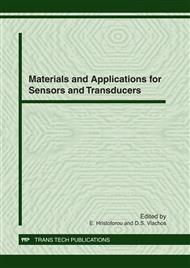p.323
p.327
p.331
p.335
p.339
p.343
p.347
p.351
p.355
Temperature Response of Magnetostrictive/Piezoelectric Polymer Magnetoelectric Laminates
Abstract:
Magnetostrictive/piezoelectric hybrid composites have recently attracted renewed interest as high sensitivity sensors and actuators. One of the most common used geometry consists in laminated amorphous magetostrictive metal/piezoelectric layers, and the maximum magnetoelectric effect has been found at the electromechanical resonance of the system. Here we present results concerning the fabrication of such laminate composites sensor by using Vitrovac 4040® (Fe39Ni39Mo4Si6B12) as the magnetostrictive amorphous component and two different piezoelectric polymers: poly (vinylidene fluoride) (PVDF) and 2,6(β-CN)APB/ODPA (poli 2,6) polyimide, a new high temperature piezoelectric polymer. We have measured room temperature induced magnetoelectric voltages of 79.6 and 0.35 V/cm.Oe at the magnetoelastic resonance of the laminate when using PVDF and poli 2,6 polyimide as piezoelectric components. We have also tested the magnetoelectric response of both laminated composites at temperatures up to 85 °C, and we have observed that the PVDF polymer piezoelectric response quickly decays. Even if the induced magnetoelectric voltage is low, we discuss the advantage of using new piezoelectric polymers due to their good performance at high temperatures, up to 200 °C, making these laminate composites suitable for high temperature applications.
Info:
Periodical:
Pages:
351-354
Citation:
Online since:
November 2011
Price:
Сopyright:
© 2012 Trans Tech Publications Ltd. All Rights Reserved
Share:
Citation:


